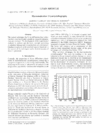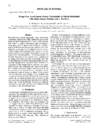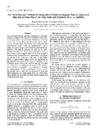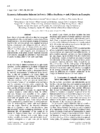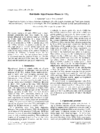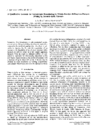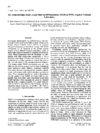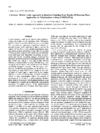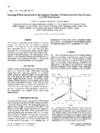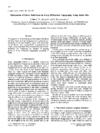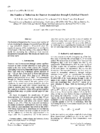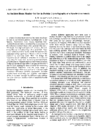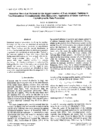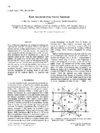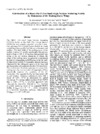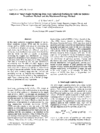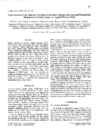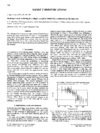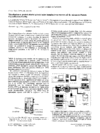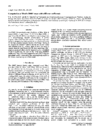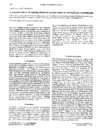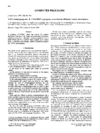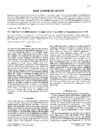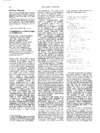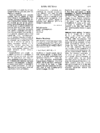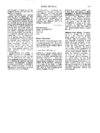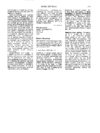issue contents
June 1997 issue

Cover illustration: A crystal of the protein phosphorylase b flash-cooled to 100 K in a 1 mm-diameter mohair loop prior to collection of X-ray diffraction data. Courtesy of Elspeth Garman and Stephen Lee, University of Oxford.
lead articles
Free 

The current techniques for X-ray diffraction data collection from macromolecular crystals at cryogenic temperatures are reviewed with emphasis on underlying principles and practical aspects.
research papers
Bragg-case synchrotron section topography has been used to reveal the depth distribution of deformation in implanted layers, and the ion ranges have been directly evaluated.
Theoretical estimates of the bias in the integrated intensities from imaging plates and an algorithm for the intensity correction for α1-α2 splitting are derived. The predictions are compared with experimental evidence based on both synchrotron and rotating-anode data.
Composite Patterson functions of α- and β-quartz were evaluated with their powder diffraction intensities. Differences in concentrations of peaks of the composite Patterson diagrams due to the difference between the space groups were detected.
Starting from rutile TiO2, we have investigated the high-pressure phases of α-PbO2 type and baddeleyite type. The bulk modulus and the equation of state for each of these TiO2 phases have been determined.
A model accounting qualitatively for anisotropic line broadening and able to produce spectacular improvements in whole-powder-pattern fitting is presented. Experimental cases support the method and show the application limits.
Antiphase structures formed in submicron areas of the fluorite-related Y2O3–Nb2O5 solid solutions have been investigated by electron diffraction and microscopy.
The design, development and performance of a time-of-flight small-angle neutron scattering instrument, SAD, are described. This provides unique advantage in monitoring a wide momentum transfer range in a single measurement and thus is effective for studies requiring information on a wider length scale such as phase transitions.
A new approach of solving crystal structures containing flexible molecules from powder diffraction data is described.
The response of gas-filled position-sensitive detectors shows a Gaussian peak as well as an exponential tail. Consequences of this effect on standard small-angle scattering experiments are discussed.
The microabsorption of X-rays in planar samples of random heterogeneous microstructure is analyzed theoretically for the nonsymmetric reflection case.
By the use of a Soller slit in X-ray topography, disturbing ghost reflections are eliminated because their reflection direction is off the plane of the main reflection.
A method is given for estimating the reflection coefficient for metal tubes from neutron transmission measurements through cylindrical channels.
An incident-beam monitor has been developed for use in synchrotron protein crystallography. The device is compact, has wide dynamic range and can be tuned to operate with high statistical acccuracy over a broad energy range.
Statistical methods that employ the meridian, midrange and the mean are used to determine the location of Bragg peaks in area-detector data.
Nacrite, a polytype of kaolinite, has space group Cc and stacking mode 2M. The two successive layers can be obtained by a mirror plane parallel to the Ox axis (8.9 Å) with -0.35a interlayer shifts along the 8.9 Å axis.
The Bonse–Hart ultra-small-angle technique, previously designed for X-ray studies, has been successfully adapted for neutron experiments.
Extensive comparison studies of the indirect transform method (ITM) and the maximum-entropy method were made for simulated small-angle scattering data with different noise levels for various size distributions. The ITM is found to be less vulnerable to termination effects and is successfully applied to the analysis of small-angle X-ray scattering data of a β-quenched zircaloy-4 specimen.
Detwinning of hemihedrally twinned crystals by means of the least-squares method allowed the use of twinned crystals for data collection in structure analysis.
A statistical method for automatically optimizing fits of X-ray rocking-curve data, using the experimental noise as a weighting criterion, is described.
Synchrotron X-ray diffraction experiments on thin single-crystal plates of CsTiOAsO4 polarized by a square-wave variable voltage of 20–1500 V alternately applied to each side of the crystal reveal information about the piezoelectric properties, coercive field strength and domain reversal.
short communications
The single-frame method of monitoring structural changes in single crystals is applied to the study of hydrogen-atom ordering in PbHAsO4 at smaller temperature steps and shorter data-collection times than in previous work.
By the use of an X-ray microbeam from a third-generation synchrotron radiation source, fibre dffraction patterns of single (≤5 μm) spider silk fibres were obtained.
Laboratory equipment is described to monitor crystal growth inside the hanging-drop reactor of the Advanced Protein Crystallization Facility.
The quality of Bhat's OMIT maps, using different amplitude coefficients for the computation of the initial electron-density distribution, was investigated.
The three weighting schemes for structure-factor amplitudes used in macromolecular crystallography, and the products of these weighting schemes, have been analysed.
computer programs
The program CONVROT converts the rotation description from any of the widely used molecular replacement systems to any other. The corresponding rotation matrix is provided for any set of rotation parameters.
laboratory notes
An easy-to-build, easy-to-use, reliable and cheap solution for single-crystal experiments at elevated temperatures up to 1300 K is proposed.
fast communications
The Fddd four-circle diffractometer system has been developed to perform X-ray diffraction experiments at temperatures as low as 9 K.
software reviews
Free 

Crystallographica, reviewed by T. Siegrist.
books received
Free 

Free 

Free 



 journal menu
journal menu









